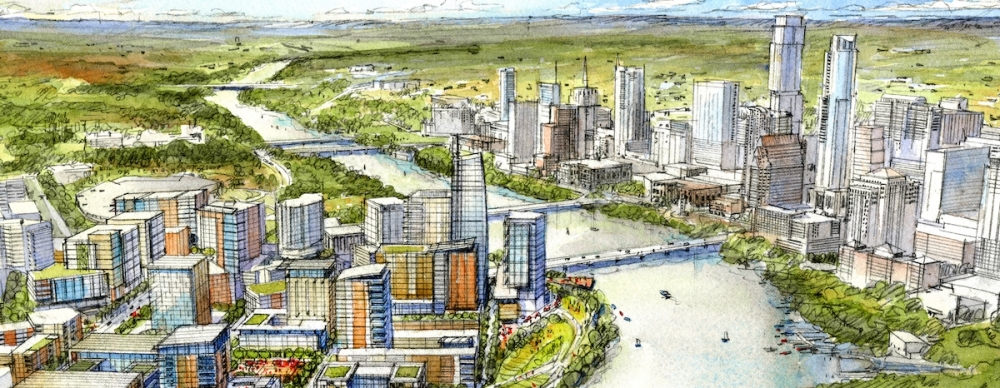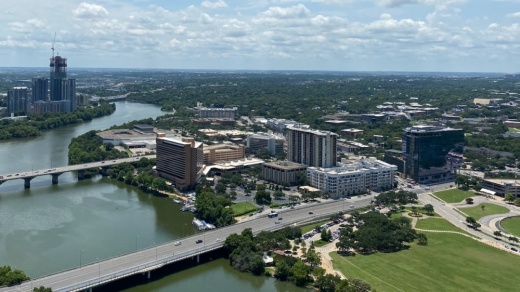Austin City Council will close out its 2021 meeting schedule by potentially approving a plan that could lay the foundation for the South Central Waterfront's redevelopment east of South First Street along Lady Bird Lake.
On Dec. 20, council will consider creating a tax increment reinvestment zone, or TIRZ, for the lakeshore district. According to the city, the TIRZ would allow for significant infrastructure work and private development along the south shore of Lady Bird Lake downtown.
The city has sought for years to encourage new development in the area based on concepts laid out in Austin's 2016 South Central Waterfront vision plan. Goals center around the district's growth and mobility, open public spaces, and housing. The proposed TIRZ covers roughly 118 acres between the lake and East Bouldin Creek from South First Street to 600 E. Riverside Drive, a stretch that includes more than 50 properties now appraised at nearly $825 million in total.
Under the subsidy program, a portion of Austin's tax revenues from local properties would go to the TIRZ rather than directly into the city's general fund collections. Through that process, funding based on expected future property tax increases within the zone would allow the city to take on up to $277 million of improvements in three phases beginning with an estimated $83.4 million on road and drainage over the coming decade. If enough revenue continues to be generated in the TIRZ, future phases would include $56.3 million in streetscaping work followed by $137.3 million in parkland, utility and water projects.
"Based on current market analysis and associated valuation projections, the TIRZ cannot fund all of the public infrastructure projects envisioned by the South Central Waterfront Vision Framework Plan," a city spokesperson said. "The city will review the performance of the zone and the resulting revenue generation annually to determine if additional capacity exists that may support tier two and three projects."
Austin has previously created tax subsidy zones for the Seaholm District, the Mueller community, the Waller Creek Tunnel project and improvements around City Hall.
Development in focus
Council's special December meeting was called to finalize the TIRZ's scope under 2021's property tax roll. Officials including Mayor Steve Adler expressed concern that delaying the TIRZ's creation to 2022 under new property appraisals could mean a lost year of revenue from new development in the area. Adler noted that for at least one large project, the 372,000-square-foot RiverSouth tower at 401 S. First St., launching the TIRZ prior to its expected February completion would allow for more revenue if it grows in value down the road.
Days before council's review of the TIRZ, the city planning commission was also considering plans for a proposed mixed-use campus that could reshape the district's waterfront.
While the commission delayed its vote on the project until January, the "Statesman PUD" at 305 S. Congress Ave. could eventually end up as a cornerstone of the district. New city parkland, roadway and millions of square feet of office, commercial and residential space are envisioned in Endeavor Real Estate Group's blueprint for the site—none of which will happen if a TIRZ is not established, its developers say.
“All of this has to happen in order to get this plan, and you can’t put it all on the back of one landowner. ... We won’t build the plan if there’s no TIRZ, it just doesn’t work. It all fits together," said Richard Suttle, the attorney representing the property owner and development team.
The city views the TIRZ as necessary to reshape the district and developers such as Endeavor are planning projects with some public benefits based around the system. However, some are concerned that the area does not meet state requirements and could end up supporting private, rather than public, interests with tax revenue flowing into the isolated TIRZ rather than Austin's general fund budget.
Per Texas tax code, the TIRZ mechanism may be used to support local infrastructure needs for locations that impair a city's growth and are "predominantly open or undeveloped." In a Dec. 17 letter to city leaders, several local attorneys urged a pause to the TIRZ process alleging it runs afoul of state guidelines and amounts to a private handout for a prime location.
“They’re proposing a $278 million tax subsidy to developers of the most valuable property in the whole city," lawyer Bill Bunch, one of the letter's authors, told Community Impact Newspaper. "That proposal violates the Texas tax code that specifically provides that this kind of tax rebate is to be used for ‘blighted’ areas that would not otherwise develop on their own. And you just simply cannot say that for this prime, lakefront property downtown.”
The city said it is moving ahead with the process given lacking streets and sidewalks and to establish a "districtwide green infrastructure system" with the belief that the waterfront area is not expected to attract new development.
"The area suffers from inadequate sidewalk and street layout and other factors, and due to its size, location, and physical characteristics, redevelopment will not effectively occur solely through private investment in the foreseeable future," the city said in its TIRZ planning document.

Samuel Franco, chair of the city's South Central Waterfront Advisory Board, said he is personally hopeful for the TIRZ as proposed. Franco said he believes following the 2016 district plan—a guiding document for the advisory board—requires additional financing in order to maximize the waterfront area's potential.
“It was always known that, for the South Central Waterfront Vision Plan to work, there had to be a funding source. The infrastructure especially, but the community benefits like the parks and open green space, the affordable housing ... none of those things were going to get built or just magically appear," Franco said.
Despite the opportunities council's vote may bring, Franco also said a greater focus is still needed on the vision plan priority to make 20% of new housing in the area affordable.
“This is great, it’s amazing, and a very, very positive step forward that we finally found a funding source," Franco said. "But me, personally, I’m a little ... frustrated that there’s not more funding and a clearer funding source for the affordable housing portion of the community benefits."
The housing question also came up during council's early December meetings. Adler said that, while he wants to see the plan's affordability goals fulfilled, a TIRZ vote is likely without all details finalized in order to move it along before the new year.
“I saw this as more a placeholder tool to be able to lock in values, with a full anticipation that we would be discussing every element of this plan in a deliberate way," Adler said Dec. 9.





